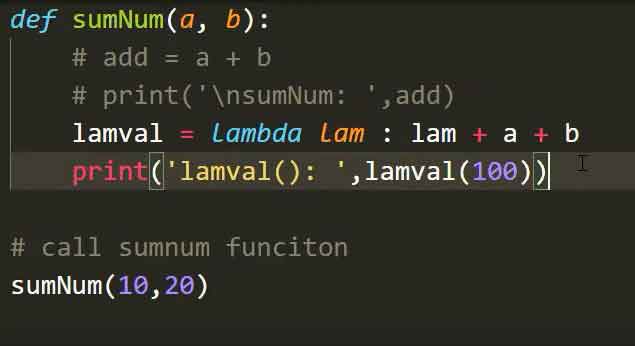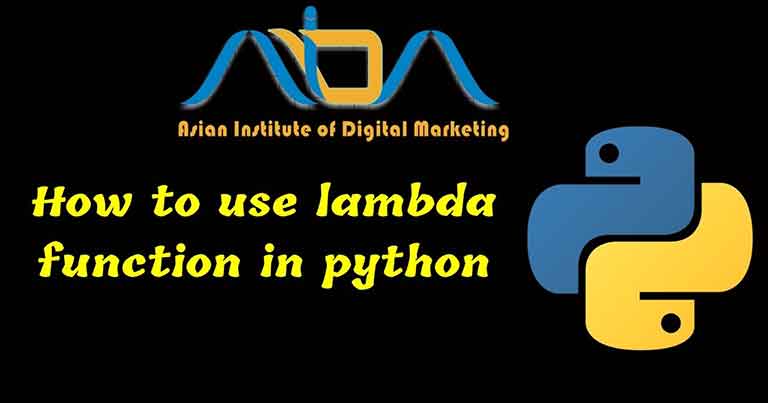Post Contents
Welcome to the series of python tutorial provided by AIDM, the best Python institute in Laxmi Nagar. Let’s go to the deep ocean of the python language.
Definition of Lambda Function in Python
A Lambda Function has a special value in Python programming, it is an anonymous function or a function having no name. It is a little and restricted function having no more than one line. Much the same as a normal function, a Lambda function can have different arguments with one expression. This function and all other function are taught in our python course in Delhi.
In Python, lambda expressions (or lambda structures) are used to develop anonymous functions. To do as such, you will utilize the lambda keyword (similarly as you use def to define normal functions). Each anonymous function you define in Python will have 3 essential parts:
- The lambda keyword.
- The parameters (or bound variables), and
- The function body.
A lambda function can have quite a few parameters, however, the function body can just contain one expression. Moreover, a lambda is written in a single line of code and can likewise be invoked immediately. You will see this inactivity in the upcoming models. All the python aspirant can join our Python Course in Laxmi Nagar to become a successful Python developer.
It will be good if you learn Data Science course in delhi yourself by joining the Django training in delhi
Syntax and Examples

The proper syntax to compose a lambda function is as given underneath:
lambda p1, p2: expression
Here, p1 and p2 are the parameters which are passed to the lambda function. You can include the same number of or not many parameters as you need.

However, notice that we don’t utilize sections around the parameters as we do with ordinary functions. The last part (expression) is any legitimate python expression that operates on the parameters you give to the function.
Model 1
Now that you know about lambdas we should attempt it with a model. In this way, open your IDLE and type in the following:
snake = lambda x, y: x + y
print (viper (1, 2))
Here is the output:
3
Grow your python knowledge with AIDM, which provide python training in Delhi.
Using lambdas with Python built-ins

Lambda functions give an elegant and powerful approach to perform operations using built-in methods in Python. It is conceivable on the grounds that lambdas can be invoked immediately and gone as a contention to these functions.
IIFE in Python Lambda
IIFE stands for immediately invoked function execution. It implies that a lambda function is callable when it is defined. We should understand this with a model; fire up your IDLE and type in the following:
AIDM offers you the best python course online, you can ask for python course fees in Delhi.
Here is the output and code clarification:
This capacity of lambdas to be invoked immediately allows you to utilize them inside functions as a guide() and reduce(). It is helpful in light of the fact that you might not have any desire to utilize these functions again.
lambdas in filter()
The filter function is utilized to choose some particular elements from a grouping of elements. The grouping can be an iterator like lists, sets, tuples, and so on.
The elements which will be chosen depends on some pre-defined constraint. It takes 2 parameters:
- A function that defines the filtering constraint
- An arrangement (any iterator like lists, tuples, and so on.)
For instance,
sequences = [10,2,8,7,5,4,3,11,0, 1]
filtered_result = filter (lambda x: x > 4, sequences)
print(list(filtered_result))
Here’s the output:
[10, 8, 7, 5, 11]
lambdas in a map()
Join our institute for the best Python Course in Laxmi Nagar and become an industry expert.
the guide function is utilized to apply a particular operation to each component in a succession. Like filter(), it likewise takes 2 parameters:
- A function that defines the operation to perform on the elements
- One or more sequences
For instance, here is a program that prints the squares of numbers in a given rundown:
sequences = [10,2,8,7,5,4,3,11,0, 1]
filtered_result = map (lambda x: x*x, sequences)
print(list(filtered_result))
Output:
[100, 4, 64, 49, 25, 16, 121, 0, 1]
lambdas in reduce()
The reduce function, similar to plan(), is utilized to apply an operation to each component in a grouping. However, it varies from the guide in its working. These are the steps followed by the reduce() function to compute an output:
Stage 1) Perform the defined operation on the initial 2 elements of the arrangement.
Stage 2) Save this result
Stage 3) Perform the operation with the spared result and the following component in the arrangement.
Stage 4) Repeat until no more elements are left.
Immediately join our Python Institute in Laxmi Nagar to become a python professional.
It likewise takes two parameters:
- A function that defines the operation to be performed
- A succession (any iterator like lists, tuples, and so on.)
For instance, here is a program that profits the result of all elements in a rundown:
sequences = [1,2,3,4,5]
from functools import reduce
item = reduce (lambda x, y: x*y, sequences)
print(product)
Here is the output:
120
As you will find in the following area, lambdas are dealt with equivalent to customary functions at the interpreter level. In a manner, you could state that lambdas give compact syntax to writing functions which return a single expression.
Why use lambda functions?
However, you should know when it is a good idea to utilize lambdas and when to evade them. In this segment, you will get familiar with a portion of the plan principles utilized by python developers when writing lambdas. At AIDM, you will be taught by the industry’s best experts, you don’t wait and join our python course fees in Delhi.
One of the most well-known use cases for lambdas is in functional programming as Python underpins a paradigm (or style) of programming known as functional programming.
It allows you to give a function as a boundary to another function (for instance, in a map, filter, and so forth.). In such cases, using lambdas offer an elegant method to make a one-time function and pass it as the boundary.
When not to use Lambda function?
You ought to never compose convoluted lambda functions in a creative domain. It will be exceptionally hard for coders who maintain your code to decrypt it. In the event that you find yourself making complex joke expressions, it would be a much better practice than define an appropriate function. As a best practice, you have to recall that straightforward code is in every case superior to complex code.
AIDM is providing the best python training in Delhi with the latest modules in their course module. If you want to pursue a python developer career, you can join us and get instant discount in the course fees.
Recommended Blog:

- Use of Boolean Datatype and Python Operators
- Use case of the tuple in python difference between list and tuple
- Python Sets And Dictionaries Python Lists, Python Sets & Dictionary
- Difference Between For and While Loop In Python
- What Are The 3 Types Of Loops In Python For Loop In Python With Condition
- Inheritance Concept In Python







